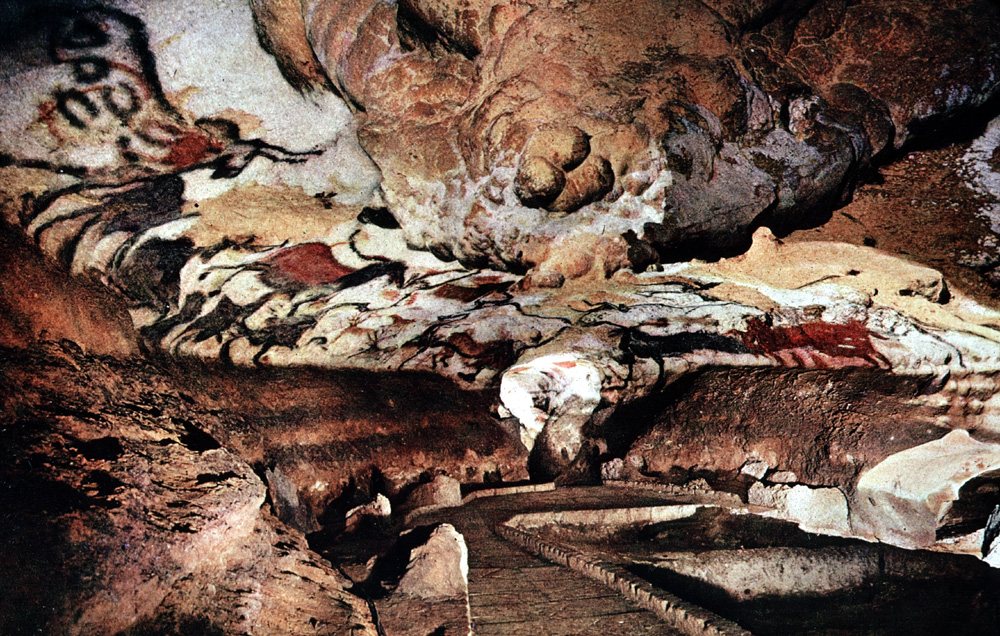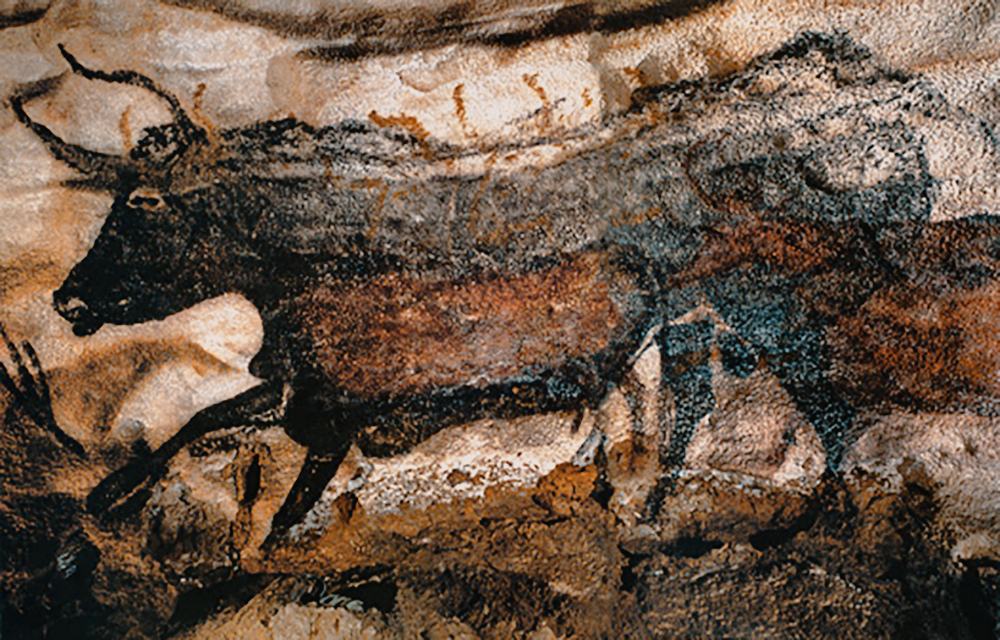
For most of our history, our race wasn’t human. Before civilization, before self-awareness, we were just another beast on the African savannah, hunting our prey and trying to survive. We didn’t ask dangerous questions or seek their answers; we didn’t have power, or luxuries, or comprehension. Somewhere along the way from there and now, we gained those properties. We looked up at the stars and wondered. We hugged a dead antelope and felt a mixture of appreciation and regret. We worshiped something greater than ourselves. We grew, not in numbers, but in depth. At some point in our history, we became human, and art was invented.
Because of its preserving nature, and the maturity of our intellect,
we have tons of artistic property from the dawn of civilization (particularly
from 3,000 BCE and on). But these new, “civilized” animals are too like us;
their problems are our problems, and their worries our worries. By studying
them we learn too much about ourselves. It’s the art from pre-agricultural societies
that can give us profound insight on the fundamentals of our psychology,
philosophy, and religion. These “humans,” existing in the shadowy realm between
man and beast, are the link to our more feral past. The problem is that
pre-Neolithic Revolution art is so scarce, and often simple. That’s why the
cave paintings at the Lascaux caves are so damn precious.
Discovered in France in 1940 by some teenagers, the grotto
contains the most outstanding displays of prehistoric art ever discovered. 250
feet of masterful illustrations, meticulously worked in cramped conditions,
these galleries necessitated substantial resources and time to complete; all
for no apparent practical advantage. Can one assume religious rituals? Or
perhaps an explosion of creative talent? Did these cavemen and cavewomen have
something to say, something to show, or something to explore? I don’t know, but
we can sure guess.
My favorite picture is the great black bull, or Auroch: massive, majestic, and now extinct. One can imagine him
running with his herd, early homo sapient watching from the foliage, in part
hoping to catch and kill the titan for food, another part awed by its power and
grace. This inner conflict—the murder of glorious life—is represented by the painting
of his eye. So many of the Lascaux critters don’t have faces or eyes, which to
me signifies abstraction. The detail of the eye in the bull suggests a
connection and confrontation significant enough the artist depicted it in his
painting. And what is the bull communicating? What can we deduce? It seems to
me that the Auroch’s glare is accusatory, somewhat sad, and probing:
“You’re going to kill
me, aren’t you? Why? Are we not brothers? No, I suppose were not. You’ve become…different.
You’re no longer like us. You’ve changed. You love me, but you need to kill me
to survive. How must that feel—to kill that which you love. To kill your
brothers. To be self-aware. To be different. To be alone in a world of life.”
How heavily this must have weighed on our early minds. Which
brings me to another work; perhaps the strangest of all Lascaux art: “Shaft of the
Dead Man.”
Understanding the
Text
Study the picture for a moment. What do you see? A seeming
human, but with a bird’s head? Being run over by a bison? Is that a crane below
them? Or a bird staff? Is that a rhino running away from the scene? What the
hell is going on! Let’s analyze it a bit, shall we?
Why does the human
figure have a human head? What does this combination suggest about the culture
that produced this scene?
When I see the unison of man and animal, I think of wish fulfillment.
So the character is drawn as part bird to reconcile the growing separation
between the human and animal world. Or the bird head is a mask the character
dons to interact/communicate with other beasts. So either the culture sees
themselves as part animal, or wants to be, and this manifests in the bird-human
hybrid depicted here.
Why is the human
figure disproportionately large compared to the bison? What kind of
relationship between humans and the natural world does the painting suggest?
Size usually equals power. I think the height of the bird character
is an assertion of human dominance in the natural order; the bison is, after
all, charging down and killing him. This is a violent scene, with the
destruction of human life and perhaps the disembowelment of the bison, while
the rhino flees the scene in terror. There seems to be recognition that humans
are climbing higher on the food chain, and are attempting mastery over the
other animals. But this control is not complete, and the bison challenges and
even succeeds in resisting human power.
But maybe not. Maybe the human is simply trying to become an
equal to the bison and rhino, greeting them as fellow animals, and is rejected.
The former attacks him, while the latter runs. Do we see the enactment of exile
from the natural order? The Lascaux paintings are dated around 17,000-13,000
BCE, which is relatively late in our development. Is this the last attempt at integration
with the animal kingdom? Is our failure here a catalyst for civilization? It’s
an enticing thought.
Some have suggested
that the figure in the drawing is a religious shaman who is in a dreamlike
trance. Is this a plausible interpretation of the painting? If so, should the
other animals be read literally or symbolically?
The odd bird totem below the bird figure seems strong evidence
for shamanism. Whether or not they’re in a “dreamlike trance” is debatable; the
proximity of the bison seems to suggest a physical, not mental interaction. But
the meta-context of the scene—on a wall in the dark recesses of a cave
structure—argue for evocation. What in the world were these painters doing down here? Why go through all the
trouble and danger of creating these galleries? What need did it serve? If we
claim these animals are to be taken literally, as mere replications of reality,
we ignore the role of art in our own world. Surely we have to see at least some
of the paintings as symbolic. Symbolic of what is again guess work. Fertility
rituals? Early Gods? The “other?”
Looking at the galleries together, there is movement here, and
narrative. Is the world depicted overwhelming the growing consciousness of man?
Is the shaman trying to cope with this expanding reality and finds himself outmatched?
From the scarcity of homo sapiens represented at Lascaux, this seems plausible.
For the first time, man views his world through an artistic lens. He is part of
a bigger picture, and struggles to find his place in it.
Based on the available
evidence, what do you believe was the purpose of the cave art at Lascaux? What
facts support your interpretation? How might this interpretation account for “The
Shaft of the Dead Man?”
Well, I see a practical reason, and then a more abstract
one. Ostensibly I think the caves were used for religious/shamanistic rituals,
mostly likely for animal/human fertility. This would justify the time and
resources poured initially into the endeavor, as the participants probably
hoped for concrete returns on such an investment. My evidence for this is the
frequency of fertility rituals among tribal peoples, and the large density of
animal life depicted compared to humans. Beyond this reasoning, however, I
would bet that early man found this kind of artistic work therapeutic and fulfilling.
Soon people found painting/crafting useful for working through inner emotions
that have no other outlet; in addition to telling stories and making sense of
the world. Lascaux represents the torrent of growing human consciousness that
must have developed from our burgeoning psychologies.
As far as “The Shaft of the Dead Man” is concerned, this
work is one such instance of that consciousness. The complexity and strangeness
of the scene is oozing with profound texture; I may not completely understand
why the artist created it, but I can feel its echoes across time. Drawing
yourself as a dead entity is a level of self-awareness that no other organism
has yet matched. The harmony of the galleries, the amount of life and vibrancy it
depicts, seems at such odds with the awkward and assaulted bird man above. In this
mural of life, we do not belong.



No comments:
Post a Comment